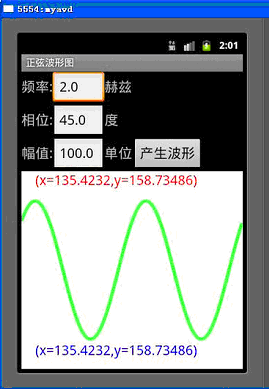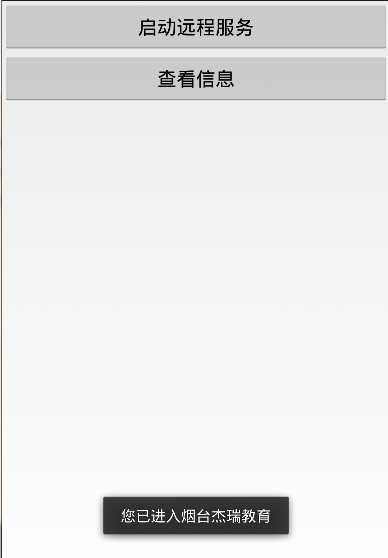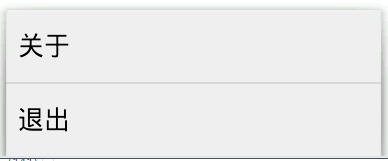正弦波大家在數學中都學過,但是在Android開發中如何繪制正弦波呢?本文將給出一個開發實例演示繪制過程。
大家先來看看最後的效果圖:

下面貼上具體的代碼:
1. layout下的main.xml文件
XML/HTML代碼
- <?xml version="1.0" encoding="UTF-8"?>
-
- <LinearLayout
-
- xmlns:android="http://schemas.android.com/apk/res/android"
-
- android:layout_width="fill_parent"
-
- android:layout_height="fill_parent"
-
- android:orientation="vertical" >
-
- <LinearLayout
-
- android:layout_width="match_parent"
-
- android:layout_height="wrap_content"
-
- android:orientation="horizontal">
-
- <TextView
-
- android:text="頻率:"
-
- android:textSize="20sp"
-
- android:layout_width="wrap_content"
-
- android:layout_height="wrap_content"/>
-
- <EditText
-
- android:id="@+id/frequency"
-
- android:textSize="20sp"
-
- android:layout_width="75dip"
-
- android:layout_height="wrap_content"
-
- android:text="3"/>
-
- <TextView
-
- android:text="赫茲"
-
- android:textSize="20sp"
-
- android:layout_width="wrap_content"
-
- android:layout_height="wrap_content"/>
-
- </LinearLayout>
-
- <LinearLayout
-
- android:layout_width="match_parent"
-
- android:layout_height="wrap_content"
-
- android:orientation="horizontal">
-
- <TextView
-
- android:text="相位:"
-
- android:textSize="20sp"
-
- android:layout_width="wrap_content"
-
- android:layout_height="wrap_content"/>
-
- <EditText
-
- android:id="@+id/phase"
-
- android:textSize="20sp"
-
- android:layout_width="75dip"
-
- android:layout_height="wrap_content"
-
- android:text="30.0"/>
-
- <TextView
-
- android:text="度"
-
- android:textSize="20sp"
-
- android:layout_width="wrap_content"
-
- android:layout_height="wrap_content"/>
-
- </LinearLayout>
-
- <LinearLayout
-
- android:layout_width="match_parent"
-
- android:layout_height="wrap_content"
-
- android:orientation="horizontal">
-
- <TextView
-
- android:text="幅值:"
-
- android:textSize="20sp"
-
- android:layout_width="wrap_content"
-
- android:layout_height="wrap_content"/>
-
- <EditText
-
- android:id="@+id/amplifier"
-
- android:textSize="20sp"
-
- android:layout_width="75dip"
-
- android:layout_height="wrap_content"
-
- android:text="100"/>
-
- <TextView
-
- android:text="單位"
-
- android:textSize="20sp"
-
- android:layout_width="wrap_content"
-
- android:layout_height="wrap_content"/>
-
- <Button
-
- android:id="@+id/wave"
-
- android:textSize="20sp"
-
- android:layout_width="wrap_content"
-
- android:layout_height="wrap_content"
-
- android:text="產生波形"/>"
-
- </LinearLayout>
-
- <com.kernel.minthen.SineWave
-
- android:layout_width="match_parent"
-
- android:layout_height="match_parent">
-
- </com.kernel.minthen.SineWave>
-
-
-
- </LinearLayout>
備注:com.kernel.minthen.SineWave系自己寫的產生正弦波的類。
2. src下的SineWave.java文件,用於根據幅度、頻率和相位設置產生正弦波,代碼如下:
Java代碼
- package com.kernel.minthen;
-
-
-
- import android.content.Context;
-
- import android.graphics.Canvas;
-
- import android.graphics.Color;
-
- import android.graphics.Paint;
-
- import android.graphics.Path;
-
- import android.util.AttributeSet;
-
- import android.view.MotionEvent;
-
- import android.view.View;
-
-
-
- import java.lang.Math;
-
-
-
- public class SineWave extends View implements Runnable{
-
- private Paint mPaint = null;
-
- private static float amplifier = 100.0f;
-
- private static float frequency = 2.0f; //2Hz
-
- private static float phase = 45.0f; //相位
-
- private int height = 0;
-
- private int width = 0;
-
- private static float px=-1,py=-1;
-
- private boolean sp=false;
-
-
-
- public SineWave(Context context){
-
- super(context);
-
- mPaint = new Paint();
-
- new Thread(this).start();
-
- }
-
- //如果不寫下面的構造函數,則會報錯:custom view SineWave is not using the 2- or 3-argument View constructors
-
- public SineWave(Context context, AttributeSet attrs){
-
- super(context,attrs);
-
- mPaint = new Paint();
-
- new Thread(this).start();
-
- }
-
- public SineWave(Context context,float amplifier,float frequency,float phase){
-
- super(context);
-
- this.frequency = frequency;
-
- this.amplifier = amplifier;
-
- this.phase = phase;
-
- mPaint = new Paint();
-
- new Thread(this).start();
-
- }
-
- public float GetAmplifier(){
-
- return amplifier;
-
- }
-
- public float GetFrequency(){
-
- return frequency;
-
- }
-
- public float GetPhase(){
-
- return phase;
-
- }
-
- public void Set(float amplifier,float frequency,float phase){
-
- this.frequency = frequency;
-
- this.amplifier = amplifier;
-
- this.phase = phase;
-
- }
-
- public void SetXY(float px,float py)
-
- {
-
- this.px = px;
-
- this.py = py;
-
- }
-
- public void onDraw(Canvas canvas){
-
- super.onDraw(canvas);
-
- canvas.drawColor(Color.WHITE);
-
- height = this.getHeight();
-
- width = this.getWidth();
-
- mPaint.setAntiAlias(true);
-
- mPaint.setColor(Color.GREEN);
-
- amplifier = (amplifier*2>height)?(height/2):amplifier;
-
- mPaint.setAlpha(200);
-
- mPaint.setStrokeWidth(5);
-
- float cy = height/2;
-
- //float py=this.py-this.getTop();
-
- for(int i=0;i<width-1;i++)
-
- {
-
- canvas.drawLine((float)i, cy-amplifier*(float)(Math.sin(phase*2*(float)Math.PI/360.0f+2*Math.PI*frequency*i/width)), (float)(i+1), cy-amplifier*(float)(Math.sin(phase*2*(float)Math.PI/360.0f+2*Math.PI*frequency*(i+1)/width)), mPaint);
-
- float point = cy-amplifier*(float)(Math.sin(phase*2*(float)Math.PI/360.0f+2*Math.PI*frequency*i/width));
-
- if((py>=(point-2.5f))&&(py<=(point+2.5f))&&(px>=i-2.5f)&&(px<=i+2.5f))
-
- sp = true;
-
- }
-
- if(sp)
-
- {
-
- mPaint.setColor(Color.RED);
-
- mPaint.setTextSize(20);
-
- canvas.drawText("(x="+Float.toString(px)+",y="+Float.toString(py)+")", 20, 20, mPaint);
-
- sp = false;
-
- }
-
- mPaint.setColor(Color.BLUE);
-
- mPaint.setTextSize(20);
-
- canvas.drawText("(x="+Float.toString(px)+",y="+Float.toString(py)+")", 20, this.getHeight()-20, mPaint);
-
- }
-
-
-
- @Override
-
- public boolean onTouchEvent(MotionEvent event) {
-
- // TODO Auto-generated method stub
-
- float px = event.getX();
-
- float py = event.getY();
-
- this.SetXY(px, py);
-
- return super.onTouchEvent(event);
-
- }
-
- @Override
-
- public void run() {
-
- // TODO Auto-generated method stub
-
- while(!Thread.currentThread().isInterrupted())
-
- {
-
- try{
-
- Thread.sleep(1000);
-
- }catch(InterruptedException e)
-
- {
-
- Thread.currentThread().interrupt();
-
- }
-
- postInvalidate();
-
- }
-
- }
-
-
-
- }
3. src下主Activity文件mySine.java,代碼如下:
Java代碼
- package com.kernel.minthen;
-
-
-
- import android.app.Activity;
-
- import android.os.Bundle;
-
- import android.view.MotionEvent;
-
- import android.view.View;
-
- import android.widget.Button;
-
- import android.widget.TextView;
-
-
-
- public class mySine extends Activity{
-
- private TextView frequency=null;
-
- private TextView phase=null;
-
- private TextView amplifier=null;
-
- private Button btnwave=null;
-
- SineWave sw=null;
-
- @Override
-
- protected void onCreate(Bundle savedInstanceState) {
-
- super.onCreate(savedInstanceState);
-
- sw = new SineWave(this);
-
- setContentView(R.layout.main);
-
-
-
- btnwave = (Button)findViewById(R.id.wave);
-
- frequency = (TextView)findViewById(R.id.frequency);
-
- phase = (TextView)findViewById(R.id.phase);
-
- amplifier = (TextView)findViewById(R.id.amplifier);
-
-
-
-
-
- btnwave.setOnClickListener(new Button.OnClickListener(){
-
-
-
- @Override
-
- public void onClick(View arg0) {
-
- // TODO Auto-generated method stub
-
- sw.Set(Float.parseFloat(amplifier.getText().toString()), Float.parseFloat(frequency.getText().toString()), Float.parseFloat(phase.getText().toString()));
-
- }
-
- });
-
- }
-
-
-
- @Override
-
- protected void onStart() {
-
- // TODO Auto-generated method stub
-
- super.onStart();
-
- frequency.setText(Float.toString(sw.GetFrequency()));
-
- phase.setText(Float.toString(sw.GetPhase()));
-
- amplifier.setText(Float.toString(sw.GetAmplifier()));
-
- }
-
-
-
- @Override
-
- public boolean onTouchEvent(MotionEvent event) {
-
- // TODO Auto-generated method stub
-
- //float px = event.getX();
-
- //float py = event.getY();
-
- //sw.SetXY(px, py);
-
- return super.onTouchEvent(event);
-
- }
-
- }
到此,正弦波的Android開發實例就講完了,希望大家能從這個簡單的例子中得到啟發。

 Android MediaPlayer(多媒體播放)
Android MediaPlayer(多媒體播放)
 Android應用程序四大組件之使用AIDL如何實現跨進程調用Service
Android應用程序四大組件之使用AIDL如何實現跨進程調用Service
 android 網絡連接處理分析
android 網絡連接處理分析
 在Android中創建菜單項Menu以及獲取手機分辨率的解決方法
在Android中創建菜單項Menu以及獲取手機分辨率的解決方法